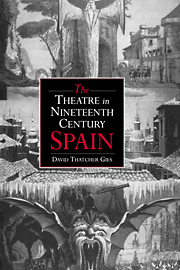Book contents
- Frontmatter
- Contents
- Preface
- Introduction: literary history and canon formation
- 1 Spanish theatre in the nineteenth century. (An overview)
- 2 Theatre and dictatorship: from Napoleon to Fernando VII
- 3 Romanticism and beyond (1834-1849)
- 4 The theatre at mid-century
- 5 “This woman is quite a man!”: women and the theatre (1838-1900)
- 6 High comedy, and low
- 7 Conflicting visions: neo-Romanticism, ridicule, and realism
- Conclusion
- Bibliography
- Index of names
- Index of plays
2 - Theatre and dictatorship: from Napoleon to Fernando VII
Published online by Cambridge University Press: 07 May 2010
- Frontmatter
- Contents
- Preface
- Introduction: literary history and canon formation
- 1 Spanish theatre in the nineteenth century. (An overview)
- 2 Theatre and dictatorship: from Napoleon to Fernando VII
- 3 Romanticism and beyond (1834-1849)
- 4 The theatre at mid-century
- 5 “This woman is quite a man!”: women and the theatre (1838-1900)
- 6 High comedy, and low
- 7 Conflicting visions: neo-Romanticism, ridicule, and realism
- Conclusion
- Bibliography
- Index of names
- Index of plays
Summary
The Revolution and the comedia
Logically, theatrical activity in the capital should have come to a halt with the invasion of Napoleon's troops in May, 1808. The city was in chaos, its inhabitants fighting heroically in the streets for their freedom, shedding blood to defend the right of the legitimate rulers of the country, the Bourbon monarchs, to remain on the throne. The theatres did close for four days during the most intense period of fighting, then opened briefly in June only to be forced again to shut their doors due to an inability to sell tickets to their performances. However, Joseph Bonaparte, Napoleon's brother, who had been installed as King of Spain, quickly perceived the value of the theatre as a useful tool in his battle to win over the hearts of his new subjects. Clearly considering the theatres to be an “instrument de propagande,” he ordered them to reopen in December, 1808 and set about trying to calm and “educate” the masses in Madrid. He subsidized the theatres directly in an effort to control them. What was forthcoming, as the power balance shifted from the French occupation force to the Spanish nationalists throughout the course of the war, was a surprising growth of theatrical activity.
- Type
- Chapter
- Information
- The Theatre in Nineteenth-Century Spain , pp. 40 - 95Publisher: Cambridge University PressPrint publication year: 1994

